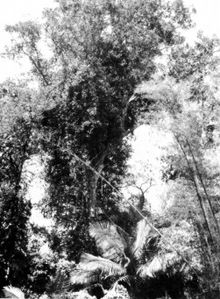Dacryodes excelsa
Appearance
| Dacryodes excelsa | |
|---|---|

| |
| Tabonuco tree (Dacryodes excelsa) | |
| Scientific classification | |
| Kingdom: | Plantae |
| Clade: | Tracheophytes |
| Clade: | Angiosperms |
| Clade: | Eudicots |
| Clade: | Rosids |
| Order: | Sapindales |
| Family: | Burseraceae |
| Genus: | Dacryodes |
| Species: | D. excelsa
|
| Binomial name | |
| Dacryodes excelsa Vahl
| |
Dacryodes excelsa is a tree native to Puerto Rico with a habitat that extends into the Lesser Antilles in the Caribbean region.[1] Its English vernacular names include gommier and candlewood.[2] Its Spanish common name is tabonuco.[3] According to Richards,[4] "it is the most conspicuous large emergent tree" in the Luquillo mountains of Puerto Rico. It is also found in Toro Negro State Forest, in Puerto Rico Cordillera Central.[5] Dacryodes excelsa grows to around 115 feet (35 m), and grows best in soil with a PH of 4.5–5.5.[6]
References
[edit]- ^ Tabonuco: 'Dacryodes excelsa' (Vahl.) USDA Forest Service. Retrieved 18 September 2013.
- ^ Dacryodes excelsa, "Candlewood": Overview. Encyclopedia of Life. Retrieved 18 September 2013.
- ^ Dacryodes excelsa (Vahl) "Tabonuco": Burseraceae, Familia de las burseras. Ariel E. Lugo & Frank H. Wadsworth. USDA Forest Service. Retrieved 18 September 2013.
- ^ Richards, P.W. (1996). The Tropical Rain Forest. An Ecological Study (2nd ed.). Cambridge: Cambridge University Press.
- ^ Bosques de Puerto Rico: Bosque Estatal de Toro Negro. Archived August 7, 2015, at the Wayback Machine Hojas de Nuestro Ambiente. July 2008. [Publication/Issue: P-030] Puerto Rico Department of Natural and Environmental Resources. Retrieved 13 September 2013.
- ^ USDA, NRCS (n.d.). "Dacryodes excelsa". The PLANTS Database (plants.usda.gov). Greensboro, North Carolina: National Plant Data Team. Retrieved 22 August 2021.
